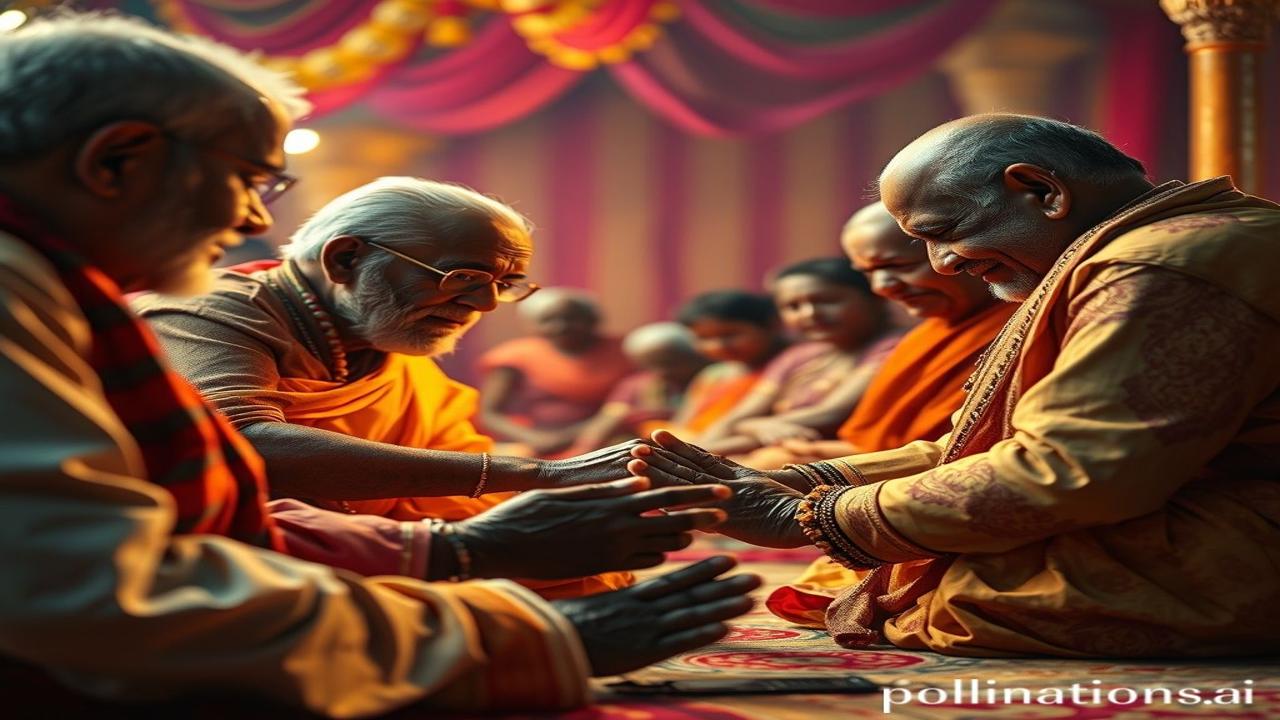Waqt Ki Dhool Mein Chhupi Ek Aashirwad: Why We Touch Elders’ Feet?
Kabhi socha hai, jab aap apne Dada-Dadi ke pair chhoote hain, toh aap sirf unhe respect nahi de rahe hote? Us lamhe mein, kitni saari kahaniyan, kitni generations ki blessings, aur kitna gehra pyaar aapke andar samaa jaata hai. Woh ek touch, ek connection hai jo humein hamari roots se jorta hai. Let’s explore this beautiful Indian tradition!
Itihasik Prishthbhoomi / Historical & Cultural Context: From Where Did This Start?
What we know as “Chhuna,” “Paer Chhuna,” or “Charan Sparsh” isn’t just a cute tradition; it’s deeply rooted in Indian philosophy and culture. We find hints of it in ancient scriptures like the Vedas and Upanishads. The practice signifies acknowledging the wisdom, experience, and blessings that elders possess.
It’s hard to pinpoint an exact date, but this gesture of reverence gained prominence during the Vedic era (around 1500-500 BCE). Imagine the ancient Gurukuls where students touched the feet of their Gurus as a sign of respect and acceptance of their teachings. This wasn’t about blind obedience; it was about recognising the Guru’s immense knowledge and seeking their blessings for enlightenment.
Why is it important? Because it’s a tangible expression of humility, respect, and a recognition of the value of intergenerational wisdom. It reinforces the importance of family and community in Indian society.
Zameeni Sach – Log Aur Jeevan / Deep Dive with Human Element: Living the Tradition
Picture this: Ma Yashoda, tired after a long day of tending to the cows and household chores, sits on the porch. Little Krishna comes running, his face covered in butter, and playfully touches her feet. Yashoda smiles, pulling him into a warm embrace. The act is spontaneous, filled with love and gratitude.
Or imagine a warrior, Rajveer, on the eve of a battle, bowing down to touch his mother’s feet. He seeks her aashirwad (blessings) for victory and protection. She, with tears in her eyes but strength in her voice, blesses him, transferring her courage and resilience to him.
“Beta, dharma ka palan karna. Maa ki aashirwad tere saath hai,” she whispers.
These are just glimpses, but they show how deeply ingrained this practice is in our lives. It’s not just about formal rituals; it’s about everyday expressions of love and respect.
Dharohar Aur Pehchaan / Cultural Significance Today: Echoes of the Past
Even today, in a fast-paced, modern India, touching elders’ feet remains a significant part of our cultural fabric. From wedding ceremonies to festivals like Diwali and Dussehra, this gesture of respect continues to connect generations.
We see it in homes, temples, and even workplaces. It’s a symbol of Bharatiyata, a reminder of our values of respect, humility, and the importance of family bonds. While the world embraces individualism, this tradition reinforces our collective identity and the significance of community. In a world full of digital communication, this physical act shows connection.
Mazedar Tathya Ya Bhram-Bhanjak / Fun Fact or Myth-Buster: Did You Know?
Log samajhte hain ki paer chhune se sirf buzurgon ko khushi hoti hai, lekin asli sach yeh hai ki science bhi isko support karta hai! Many believe that touching the feet of elders creates an energy circuit. When you bow down and touch their feet, you are connecting your “positive” energy with their “positive” energy, creating a flow of positive vibes! Pretty cool, right?
Drishya Aur Bhavnaayein / Visual & Sensory Layer: Feel the Moment
Imagine the air thick with the fragrance of incense and sandalwood. The temple bells chime, creating a rhythmic melody. The cool marble floor beneath your bare feet as you approach your grandmother. Her hands, wrinkled with age, gently caress your head as she blesses you. You feel a sense of peace and belonging wash over you. The warmth of her blessing is a comforting embrace in a chaotic world.
Antim Vichar Ya Uddharan / Closing Insight or Quote: The Final Word
“Matru devo bhava, Pitru devo bhava, Acharya devo bhava, Atithi devo bhava” – (Taittiriya Upanishad)
This ancient shloka reminds us to treat our mother, father, teacher, and guests as divine. Touching elders’ feet is a physical manifestation of this profound respect and reverence. It’s a reminder to cherish the wisdom and blessings that elders offer, and to carry forward the values that have shaped our civilization for centuries. It’s more than just a tradition; it’s a connection, a blessing, and a piece of our soul.
